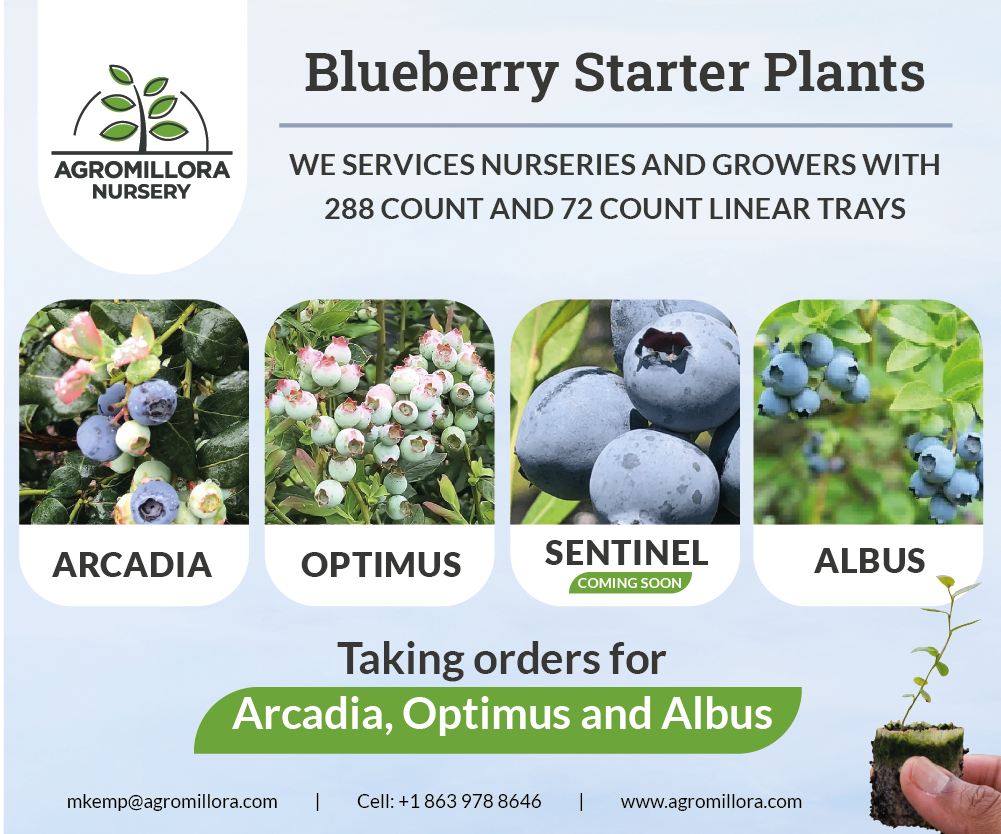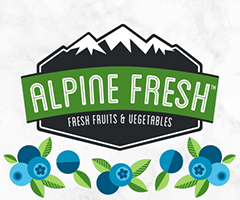Basics of Blueberry Irrigation Management for Florida Growers
credit: JEFF WILLIAMSON & DOUG PHILLIPS
Irrigation is an important cultural practice as blueberry plants emerge from winter, initiate growth, and move through the various stages of flowering, fruit set, fruit development, and postharvest summer growth. Irrigation requirements change throughout the year based on crop development and weather. Water movement through the soil, plant, and atmosphere is governed by water potential. Water moves from high to low water potential. Generally, water potential is highest in the soil and lowest in the atmosphere, facilitating the movement of water from the soil through the plant to the atmosphere. If the soil becomes too dry, its water potential is low, and this can interfere with water uptake by plants.
As a crop, blueberries are particularly susceptible to drought stress due to the shallow root systems and the absence of root hairs (Figure 1). Moreover, they are often grown in sandy soils that are highly amended with pine bark or directly in pine bark beds. The water-holding capacities of sands amended with bark or pine bark beds can vary considerably depending on the amount of bark used and its level of decomposition. However, in general, pine bark and Florida’s sandy soils do not retain water very well. Therefore, modifications to standard irrigation practices may be necessary to keep the blueberry root zones sufficiently moist to meet plant water demands.
In general, frequent, light applications of water are beneficial for maintaining adequate soil moisture in the blueberry root zone without applying excessive water that will move below the root zone, contribute to leaching of fertilizers and pesticides, and be unavailable for plant uptake.
Blueberry water requirements are highly variable depending on crop development, weather, and canopy size. A mature blueberry planting may require roughly 40 inches of water (irrigation and rainfall combined) annually, depending on plant spacing and canopy coverage of the field. During periods of fruit development or high canopy growth, water in excess of 1 inch per week may be required. For example, in a study in North-Central Florida, mature “Emerald” plants used an average of about 2 gallons of water per day during the peak periods of water use in May and again from July through September. Two gallons applied evenly to a bed area of 3 by 4 feet would be approximately 0.27 inches of water applied to that area. During periods of high water demand, shorter duration irrigation events applied multiple times per day will increase water use efficiency and reduce potential leaching of fertilizers and pesticides compared to longer, less frequent, irrigation events. The frequency of irrigation events will also depend on weather conditions, cultivar, production system, and the use and condition of pine bark as a substrate or amendment. The goal should be to keep the root zone moist without applying water below the root zone. Knowledge of crop water demand, average rooting depth, and the water-holding characteristics of soil will help achieve this goal.
Knowing when to apply irrigation is critical to meeting plant water needs in advance of drought stress. Drought stress can impair vegetative and reproductive growth and make plants more susceptible to diseases such as stem blight. Soil-moisture sensors can supply data on water content at different depths, providing growers with the information needed for proper irrigation scheduling. This information can potentially reduce water use while maintaining or enhancing plant growth and fruit quality. The goal is to keep soil moisture within a targeted range by replacing water lost through evapotranspiration. Common groups of moisture sensor types include those that measure soil water content (volumetric), and those that measure soil water tension (the force of adhesion of water to soil particles) Sensors measuring soil water content can indicate both when and how much to irrigate. See UF EDIS Publication BUL343, Field Devices for Monitoring Soil Water Content (https://edis.ifas.ufl.edu/pdffiles/AE/AE26600.pdf) for more details.
Sensors that measure water tension may not work well in most Florida blueberry fields because of the high sand and bark content of the soil. Sensors should be placed in accessible areas away from field edges in areas that are representative of the field in which they will be measuring moisture. Sensor depth should be within the root zone. Sensors placed at different depths will provide more information. Sensors placed close to the soil/bark surface will signal when to irrigate, and sensors at a lower depth (toward the bottom of the root zone) will indicate how far the water has penetrated, indicating how much to irrigate. If only one sensor per site is used, it should be placed at a depth in the middle of the root zone. In fields with significant variability (e.g., slope, wetness, cultivar type, plant age, etc.) multiple sensor sites should be established.
Consideration of the nature of the blueberry root system, the use of pine bark beds, varying blueberry water needs throughout the year, and available tools for monitoring root zone moisture will help growers establish and maintain efficient irrigation practices, and avoid excess water use and leaching of nutrients below the root zone.
Figure 1. Excavated southern highbush blueberry plant grown in a pine bark bed. The shallow, fibrous root system was primarily limited to the depth of the pine bark, with very few roots penetrating the underlying soil.





